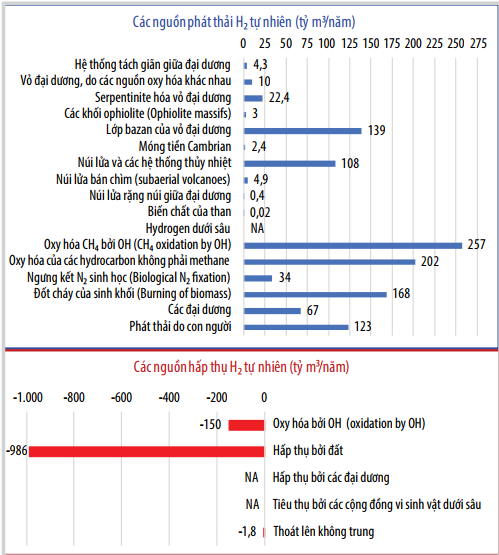Hydrogen accounts for 75% of ordinary matter by mass, over 90% by atomic number, and is the third most common element on Earth's surface, mainly found in chemical compounds such as water and hydrocarbons. When burned, hydrogen produces heat and water without polluting the environment, making it a promising clean energy source for the future.
Currently, hydrogen is primarily produced industrially through thermal processing of fossil fuels like coal and natural gas, as well as from water electrolysis. Natural hydrogen deposits have been discovered around the world, particularly in relatively pure underground reservoirs. Test extraction and power generation using hydrogen in Bourakebougou, Mali, demonstrate the potential for exploring and exploiting natural hydrogen from underground. This article introduces global natural hydrogen discoveries and proposes exploration efforts in Vietnam.
1. Introduction
Energy transition is a strong global trend, aiming to reduce fossil fuel consumption, increase energy efficiency, minimize environmental impact, combat climate change, and reduce greenhouse gas emissions. Hydrogen, when combined with oxygen, does not produce carbon dioxide, hydrocarbons, sulfur oxides, nitrogen oxides, or ozone. As a clean-burning, environmentally friendly fuel, hydrogen offers an efficient energy source that addresses air pollution and global warming issues.
Hydrogen plays a crucial role in energy transition. To achieve the goals set by the 26th United Nations Climate Change Conference (COP26), which seeks to limit global temperature rise to below 2°C and ideally under 1.5°C in the 21st century compared to pre-industrial levels, global CO2 emissions from energy activities must drop by approximately 60% by 2050, while the world’s population is projected to grow by 2 billion people. Hydrogen has seven main roles in energy transition:
i) Electricity generation and large-scale renewable energy integration;
ii) Energy transmission and distribution across regions and sectors;
iii) Energy storage to stabilize systems;
iv) Decarbonizing transportation;
v) Decarbonizing industrial energy use;
vi) Decarbonizing residential energy use;
vii) Providing clean materials for industrial production.
Currently, hydrogen is industrially produced through thermal processing of fossil fuels, such as coal and natural gas ("grey hydrogen"), which inevitably leads to high CO2 emissions. "Blue hydrogen" is produced through thermal processing of hydrocarbons combined with Carbon Capture and Storage (CCS) technology, which mitigates CO2 emissions, but this process increases production costs by approximately 1.5 times. "Green hydrogen," produced through water electrolysis using renewable energy, is environmentally friendly and free of CO2 emissions, though it is more expensive than the other methods. However, advancements in electrolysis technology and the growing use of renewable energy (especially wind and solar power) are reducing these costs. Hydrogen production from biomass, algae, and other biological processes is still under research and testing.
2. Natural Hydrogen Discoveries Worldwide
The belief that "free hydrogen in nature is extremely rare" has influenced gas sampling, detection system design, and analysis in hydrogen exploration. Oil and gas exploration wells have typically been drilled into sedimentary basins, which are not the primary locations for abundant hydrogen. Due to hydrogen's rapid diffusion in air and through various materials, gas samples containing hydrogen require specific handling methods. Hydrogen, being highly reactive, forms water when combined with oxygen and leaves no trace of free gas. It is also easily consumed or broken down by microorganisms.
Hydrogen leaking from natural hydrothermal systems in mid-ocean ridges has been detected since the 1970s. Hydrogen has also been observed on land in ophiolite zones in places like Oman, New Caledonia, Turkey, and the Philippines. Studies by Viacheslav Zgonnik and AFHYPAC have shown that hydrogen is present in various locations across the globe.
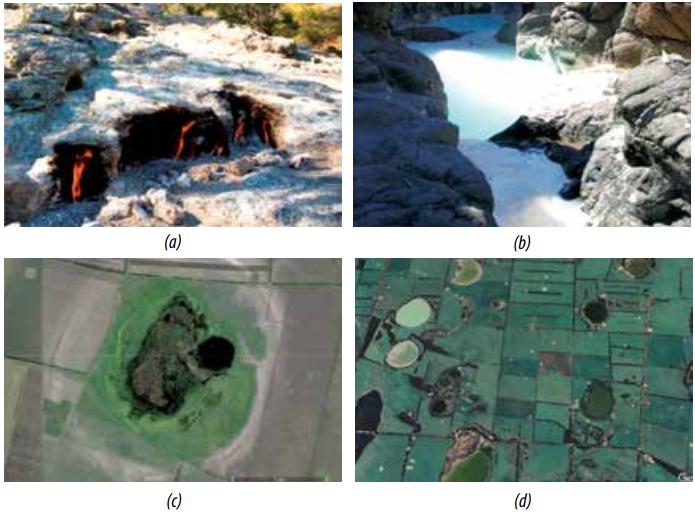
Figure 1. a) The eternal flame of Chimera in Turkey [2], b) Area of hydrogen discovery with blue gas in Oman [3], c) Area of hydrogen discovery at Lake Podovoye – Voronezh region, Russia [3], d) Kangaroo Island, South Australia, where drilling revealed a high hydrogen content (84%) [4].
- Hydrogen-rich hydrothermal fluids in mid-ocean ridges, such as the East Pacific Ridge and Mid-Atlantic Ridge, have been discovered, as well as in continental hydrothermal systems like those in Iceland.
- In deep and ultra-deep boreholes, several kilometers deep, that study underground structures in Kola and the Ural Mountains (Russia) and Kryvyi Rih (Ukraine).
- In volcanic gases from Mount Etna (Sicily, Italy), Augustine and Trident (Alaska, USA), Klyuchevskoy (Kamchatka, Russia), and others.
- In hyperalkaline waters associated with various ophiolite-peridotite zones, such as in Oman and Zambales (Philippines), southern Turkey, and in kimberlite pipes in Russia.
- In large active fault zones, such as the San Andreas Fault (California, USA) and the Antera Fault (Japan).
- In various ore deposits, including iron, gold, uranium, mercury, nickel, copper, polymetallic, niobium-tantalum, and tungsten-molybdenum, especially in South Africa and Russia.
- In some oil and gas fields, particularly in the USA, Russia, Belarus, and Uzbekistan.
- In coal deposits in Russia, Ukraine, etc.; in salt formations in Germany and Russia; in sedimentary rocks in Russia, Latvia, and New Zealand; in igneous rocks in Russia; and in metamorphic rocks in the USA, Finland, and Russia.
- In inclusions (enclaves) within sedimentary, igneous, and metamorphic rocks, ore samples, coal samples, and salt formations found in many parts of the world.
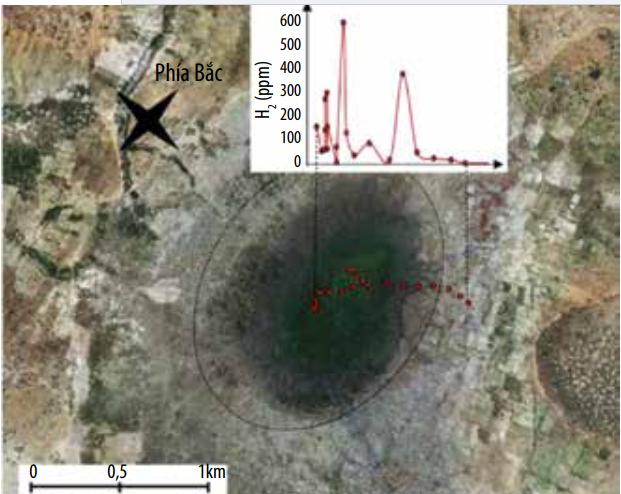
Figure 2. Surface geochemistry over a circular structure in Bourakebougou (Mali) [5].
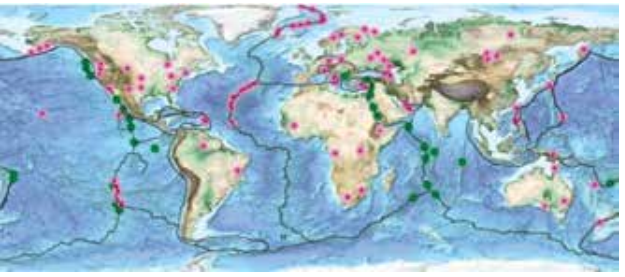
Figure 3. Signs of H2 emissions (red) and CH4 emissions derived from H2 (blue) [6].
- In certain areas with geysers, hot springs, and mud volcanoes, such as in Iceland, Russia, the USA, Japan, etc.
- In groundwater samples and water samples from oil and gas fields in Russia, Belarus, etc.
Hundreds of geological structures emitting H2 gas have been found in the Russian Federation, North Carolina (USA), São Francisco (Brazil), Azerbaijan, Latvia, and other locations. These structures often have shallow, circular or semi-circular depressions, with surface diameters ranging from hundreds of meters to several kilometers. At the center, there are swamps or even lakes. In the periphery of these structures, soil discoloration is observed along with abnormal vegetation growth. These discoveries share common conditions: accompanying circular to semi-circular depressions; located in areas with iron-rich Precambrian crystalline basement rocks, where Fe²⁺ oxidation and H₂O reduction processes may occur [2].
Information on the discovery of natural hydrogen is presented in Table 1. Compiled from Viacheslav Zgonnik's statistical data [2], the highest average hydrogen content (45-66%) is found in the following types of natural hydrogen occurrences: hydrogen trapped in magmatic rocks (66.1%), hydrogen in rift zones (62.8%), hydrogen inclusions in ultrabasic rocks (55.1%), hydrogen in ore inclusions (54%), hydrogen associated with magmatic rocks (53.6%), hydrogen in inclusions from Precambrian rocks (53.1%), hydrogen in kimberlite pipes (51.9%), hydrogen associated with Precambrian rocks (50.3%), hydrogen in ophiolite bodies (48.4%), hydrogen in sedimentary rocks (48.3%), and hydrogen inclusions in sedimentary or metamorphic rocks (45%). Natural hydrogen associated with oil and gas fields has the lowest average content, around 25.5%. A map showing the locations of hydrogen and methane emissions sourced from hydrogen discharge was presented in the study by Isabelle Moretti and M.E. Webber [6] (Figure 3).
The presence of hydrogen in nature is still considered a "geological mystery" to this day. The exploration and discovery of relatively pure hydrogen reservoirs, along with test extraction and the use of hydrogen for electricity generation in Bourakebougou (Mali) since 2020, have demonstrated the potential for exploiting natural hydrogen. Observations on a circular structure revealed a consistent upward hydrogen leakage. The hydrogen is believed to originate from the crystalline basement, as it is accompanied by significant amounts of helium and radiogenic argon.
3. Classification and origin of natural hydrogen discoveries
Excluding hydrogen discoveries from mid-ocean ridges and other oceanic locations, natural hydrogen discoveries are classified into three main types: free hydrogen gas, hydrogen in rock inclusions, and hydrogen dissolved in water [2]. However, in many cases, clear classification is difficult.
Natural free hydrogen gas: The earliest discoveries were associated with ophiolites in Chimaera, near Antalya, Turkey, over 2,500 years ago, and the "Eternal Flames" in the Philippines about 25 years ago. Free hydrogen gas has also been found in or associated with many other formations, such as ancient Precambrian rocks; ultra-deep boreholes (up to 5 km or deeper), such as in Kola and the Urals (Russian Federation); in volcanic gases; in geysers and hot springs, and hydrothermal systems related to volcanic activity, such as mud volcanoes; kimberlite pipes; iron, gold, uranium, mercury, nickel, copper, and polymetallic deposits like niobium-tantalum and various tungsten-molybdenum deposits; oil and gas fields; coal basins; sedimentary basins; and in salt accumulations.
Hydrogen in diffusive flow: Several studies have indicated that hydrogen diffuses through the Earth's crust to the surface [2, 7, 8]. Surface gas measurements have shown an area with abnormally high hydrogen concentrations (up to 6,000 ppm or 0.6%) extending over more than 7,000 km² and stretching 85 km westward from some hydrogen-rich exploratory boreholes in Kansas, USA. This area of high hydrogen concentration in soil gas appears to be associated with gravity and magnetic anomalies defining the North American Mid-Continent Rift System [2, 9]. Recent studies have identified thousands of sites with hydrogen outflow in eastern Russia [10], along the Atlantic coastal plain of the USA [11], Brazil [12], Mali [2], Oman [13], and the western Alps of France and Italy [14].
Hydrogen associated with faults and inert gases: Faults serve as natural conduits for fluids. Research conducted at the San Andreas Fault (California) and Duchesne Fault (Utah) in the USA shows a correlation between hydrogen and helium concentrations in soil and deep fault zones [15]. Geochemical sampling of hydrogen in the USA has been used to map faults related to mineral deposits in the Trans-Challis fault system in Idaho and the Carlin Trend in Nevada. Hydrogen data from hundreds of soil gas measurements in north-central Kansas, USA, indicate that fractures act as vertical conduits for hydrogen migration [16]. Geophysical studies in the Moscow region (Russian Federation) show a correlation between observed hydrogen concentrations and deep faults [17].
Hydrogen in inclusions: Hydrogen has been discovered as a major gas (trapped inside rocks as inclusions or adsorbed) in many types of rocks, such as ancient Precambrian rocks, magmatic rocks, volcanic rocks, ores, coal samples, sedimentary rocks, metamorphic rocks, and salt formations. Each type of rock releases gas with a characteristic composition.
Hydrogen dissolved in groundwater: A significant number of natural hydrogen occurrences have been observed as dissolved gas in groundwater. Studies in the Russian Federation and the former Soviet Union [18] have shown higher hydrogen concentrations in groundwater in many regions/structures, such as those related to recent tectonic activity, volcanic craters, deep fault zones, and rift zones. High hydrogen concentrations were found in groundwater sampled from fractured rocks in 24 exploratory wells in South Africa [19].
Researchers have proposed various hypotheses regarding the formation process and origin of hydrogen in the Earth's crust [2], including:
- Hydrogen degassing from deep within the Earth's core and mantle (the amount of hydrogen in samples increases with depth in deep and ultra-deep boreholes studying the structure. Gas samples from the Kola Superdeep Borehole in Russia, the world's deepest borehole, are rich in hydrogen);
- Reaction of water with ultramafic rocks or serpentinization (many sites have recorded hydrogen-rich gas leakage related to ophiolite outcrops. Most current geological hydrogen sources are considered reactions of water with minerals, speculated to be the sole source of natural hydrogen production through serpentinization or other reactions);
- Interaction of water with exposed fresh rock surfaces (hydrogen can form in rocks from the reaction of water with fresh rock surfaces along active fault zones or from the reaction of free radicals on fresh rock surfaces with water);
- Decomposition of hydroxyl groups in the crystal lattice structure of minerals (water contacts and reacts with minerals containing Fe (II));
- Natural radiolysis of water (related to the radioactive decay of elements associated with the change in atomic valence states);
- Decomposition of organic matter (anaerobic decomposition of organic matter, fermentation);
- Biological activity (decomposition by nitrogen-fixing bacteria, activity of microbial communities capable of producing hydrogen located deep in the ocean and in fault zones in the Earth's crust...);
- Human-induced activities (exhaust gases from fossil fuel-powered vehicles, hydrogen detected in boreholes due to reactions between water and steel casing, iron and steel extraction equipment...);
- Hydrogen in the atmosphere (from human, biological, and water photolysis processes, as well as the oxidation of methane and other hydrocarbons);
- Hydrogen formation at volcanoes and hydrothermal systems (volcanic emissions, including hydrogen from hydrothermal systems at mid-ocean ridges, of volcanic origin).
Some studies have proposed a mixed origin of hydrogen, combining various factors. The reason for multiple explanations of hydrogen’s origin is due to the ubiquity of hydrogen and incomplete understanding of its “nature and behavior.” Hydrogen is a primary element in water molecules, in many types of minerals, in living organisms, organic matter, and hydrocarbons.
It is estimated that natural hydrogen emissions from various sources amount to approximately 1.145 billion cubic meters per year, with the oxidation of methane and other hydrocarbons being the largest emission sources. Approximately 1.138 billion cubic meters of natural hydrogen are also absorbed by various factors, with the Earth's subsurface being the largest natural hydrogen sink (Figure 4).
4. Discovery of Natural Hydrogen Accumulation at Bourakebougou
Natural hydrogen was discovered by Hydroma Inc. in the Bourakébougou region (about 50 km northwest of Bamako, the capital of Mali) in 1987. Hydroma Inc. (formerly Petroma Inc.) specializes in the research, development, and exploitation of natural hydrogen, oil, and gas. Hydroma Inc. holds 100% interest in Block 25 in Mali, which spans an area of 43,174 km², and has a license to explore hydrogen within an area of 1,264 km². This is the world's first major discovery of natural hydrogen, and hydrogen has been trial-extracted from one borehole to produce electricity for the village of Bourakébougou in Mali without CO2 emissions.
Regarding the discovery of natural hydrogen accumulation at Bourakebougou (Mali) [5], the first water exploration well at Bourakebougou ("Bougou-1") was drilled in 1987 within Proterozoic sedimentary formations, interbedded with Triassic-aged dolerite sills. The significant presence of hydrogen gas in all exploration wells indicates the existence of a large natural hydrogen system. Gas obtained at a depth of approximately 112 meters in the Bougou-1 well contained 98% hydrogen (nearly pure hydrogen) with traces of nitrogen and methane (1% nitrogen and 1% methane). Figure 5 shows the gas with the highest hydrogen content in the Bougou-1 well (in Mali), while other hydrogen leaks in the region are also substantial.
Table 1. Summary of Natural Hydrogen Discoveries [2]
|
TT |
Detection type |
Total number of detections |
Depth (m) from - to |
H 2 content (%) from - to/average |
Origin (number of findings) |
|
1 |
Hydrogen discoveries associated with ophiolite bodies |
16 (Oman - 5, Philippines 4, USA - 3, Türkiye -2, New Caledonia -1, Bosnia Herzegovina -1) |
|
7.5 - 99/48.4% |
1.Serpentinite? (14) 2. Mixture of organic heat-generating gas and allergenic gas?(1) 3. Oxidation of Fe 2 + by water?(1) |
|
2 |
Hydrogen discoveries associated with rift zones |
4 (USA -2, Iceland - 2) |
|
33.7 - 96.3/62.8% |
4. Accompanying the continental rift system? ⑵' 18. Unknown (2) |
|
3 |
Hydrogen discoveries associated with Precambrian rocks |
10 (USA - 4, Finland - 2, Russian Federation - 2, Australia - 2) |
290-2,300 m |
3.9 - 91.8/50.3% |
1.Serpentinite? (3) 5. Mixture? (3) 6. Interaction between water and iron compounds or magma rocks? (1) 18. Unknown (3) |
|
4 |
Hydrogen discoveries associated with magmatic rocks |
5 (Russian Federation - 5) |
40.6 - 3,770 m |
20.6 - 80.5/53.6% |
5. Mixture, mainly inorganic?(1) 18. Unknown (4) |
|
5 |
Hydrogen discoveries associated with gases from volcanic eruptions |
17 (Iceland - 5, Russian Federation - 4, USA - 3, Japan - 3, Italy -1, Congo - 1) |
|
6 - 93/38.3% |
4. Accompanying the continental rift system? (1) 7. H2S reacts with water? (1) 18. Unknown (1;) |
|
6 |
Hydrogen discoveries have been accompanied by gases from geysers, hot springs, mud volcanoes and standalone seeps. |
10 (Iceland - 4, USA -1, Japan - 1, China - 1, France -1, Azerbaijan -1, El Salvador - 1) |
|
2.4 - 51.4/24.9% |
18. Unknown (6) |
|
7 |
Hydrogen discoveries in kimberlite pipes |
2 (Russian Federation - 2) |
365 - 370 m |
48.8 - 58.9/51.9% |
18. Unknown (2) |
| 8 | Hydrogen discoveries associated with ore bodies |
27 (Russian Federation -19, South Africa - 4, Ukraine - 2, Uzbekistan - 1, Kazakhstan - 1) |
53-2,192 m | 7.1 - 98.5/42.8% |
8. Reaction of H2 current in clay (1) 9. Magma?⑵ 10. From below?(1) 18. Unknown (23) |
| 9 | Hydrogen discoveries accompany oil and gas fields |
16 (Russian Federation - 7, USA - 5, Uzbekistan -1, Azerbaijan -1, Estonia -1 ,Belorussia -1) |
27 - 2,589 m | 6 - 95.2/25.5% |
5. Mixture, mainly inorganic?(1) 18. Unknown (15) |
| 10 | Hydrogen discoveries accompany coal reservoirs | 8 (Russian Federation - 5, Ukraine - 2, Kazakhstan -1) | 10 - 95.4/38.9% |
18. Unclear (6) |
|
| 11 | Hydrogen discoveries associated with sedimentary rocks |
26 (Russian Federation -15, Latvia - 2, USA - 2, Kyrgyzstan - 2, Uzbekistan -1, Kazakhstan -1, Poland -1, New Zealand -1, Mali -1) |
109 - 5,500 m | 4.2 - 98/48.3% |
5. Mixture, mainly inorganic?(1) 10. From deep below?(3) 11. Biology?⑴ 18. Unknown (21) |
| 12 | Hydrogen discoveries associated with salt formations |
12 (Germany - 7, Russian Federation - 3, France -1, Denmark -1) |
8.4 - 93/33.4% |
5. Mixture, mainly inorganic?(1) 12. Organic matter?(1)
18. Unknown (10) |
|
| 13 | Hydrogen discoveries accompany faults | 3 (USA - 2, Japan -1) | 9.4 - 70/30.9% |
13. Due to reactions of water with rock (fresh fractures?⑵ 14. Due to the separation of Fe(OH) 2 ?(1) |
|
| 14 | Hydrogen inclusions detected in ultrabasic rock samples | 3 (Russian Federation - 3) | 15 -100/55.1% |
18. Unknown (3)
|
|
| 15 | Hydrogen inclusions found in pre-Cambrian rock samples | 10 (Russian Federation - 6, Greenland - 4) | 8 - 97.8/53.1% |
18. Unknown (10)
|
|
| 16 | Hydrogen inclusions detected in rock samples of magmatic origin | 23 (Russian Federation - 20, Georgia - 1, Canada - 1, Kazakhstan -1) | 5.1 - 100/66.1% |
10. From below?(1) 15. From plutonic (deeply penetrating) bodies? (3) 18. Unknown (19) |
|
| 17 | Hydrogen inclusions detected in extrusive rock samples | 7 (Russian Federation - 7) | 19 - 90.4/36.1% |
18. Unknown (7) |
|
| 18 | Hydrogen inclusions detected in ore samples |
20 (Russia-11, Canada-2, Uzbekistan-2, Kazakhstan-2, Ukraine-1, Cyprus-1, Gabon-1) |
3 - 100/54% |
16. Radiolysis? (3) 18. Unknown (17) |
|
| 19 | Hydrogen detected in samples taken from coal mines | 11(Russia-9, Ukraine-1, Kazakhstan-1) | 11.4 -1/29.8% |
18. Unknown (11) |
|
| 20 | Hydrogen inclusions in sedimentary or metamorphic rocks | 3 (Russia-2, Ukraine-1) | 5.2 - 66.6/45% |
17. Endogenic? (2) 18. Unknown (1) |
|
| 21 | Hydrogen inclusions in samples from salt-bearing formations | 6 (Russia-2, Kazakhstan-2, Ukraine-1, Belarus-1) | 1.1 - 34.6/23.2% |
18. Unknown (6) |
|
| 22 | Hydrogen detected in water samples |
54 (Russia-41, Australia-3, Ukraine-3, Canada-2, USA-2, South Africa-1, Kazakhstan-1, Poland-1) |
407 - 3,350 m | 1.8 - 76/20.6% |
1.Serpentinite? (2) 5. Mixture, mainly inorganic?(1) 10. Deep down? (6) 16. Radiolysis? (2) 18. Unknown (43) |
| 23 | Hydrogen detected in water samples collected in oil and gas fields |
14 (Russia-9, Belarus-4, Kazakhstan-1) |
534 - 3,500 m | 5.1-98/27.9% |
18. Unknown (14) |
|
Figure 4. Sources of Natural H2 Emissions (Top) and Absorption (Bottom) [2]. |
The surface of the Earth (Oman, Turkey, New Caledonia, Philippines) consistently shows higher concentrations of methane and nitrogen. Geochemical data do not indicate the presence of source rocks with oil and gas potential in this area.
The 2017–2018 exploration campaign in Bourakébougou completed 24 wells within an 8 km radius, with well depths ranging from 105 to 1,807.4 meters. The total length of core samples collected reached 5.4 km. These wells (Figure 6) allow an estimated verified hydrogen gas reserve area of up to 780 km².
The Neo-Proterozoic sediments are characterized by sandstone, marl, siltstone, conglomerate, and limestone. Facies studies show that carbonate rocks are composed of calcite, dolomite, and siderite. Only one well drilled down to the basement (Bougou-6) encountered basement rocks consisting of deep plutonic intrusions, including granite, granodiorite, diorite, syenite, and aplite. The mineral composition includes iron-containing minerals such as magnetite, hematite, pyrite, and chalcopyrite. |
Exploration wells in Mali confirm the presence of hydrogen flow in this area. Gas was continuously detected while drilling the exploration wells, with H2 being predominant and varying methane levels found in all the wells. The H2/CH4 ratio ranged from 10 to 500 (in the Bougou-1 well, the ratio was 98). Traces of H2S and CO (both with concentrations above 1,000 ppm) were identified in some exploration wells. The origin of H2S gas is believed to be related to interactions between sulfur and other compounds (H2, H2O), potentially produced through biological activity in shallow areas.
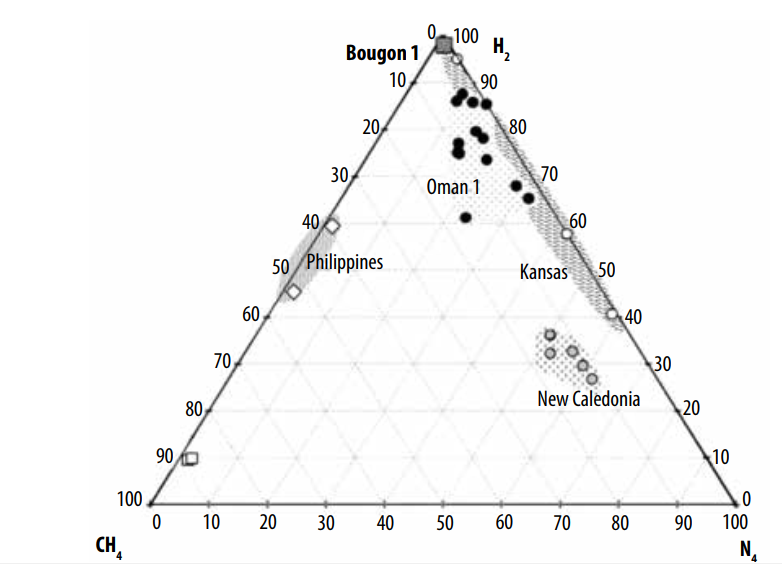
Figure 5. Triangular diagram showing the relative proportions of hydrogen, methane, and nitrogen for natural hydrogen-containing gas samples worldwide: Oman, Philippines, New Caledonia, Turkey (gas leaks); Kansas, USA (gas production well tests) [5].
Cross-sections through the exploration wells have identified at least five stacked hydrogen-rich reservoirs in the area (the shallowest being near 100 meters), separated by dolerite sills (Figure 7). The main reservoir rock in this area is carbonate rock, although hydrogen is also present in sandstone and other rock types. Hydrogen accumulation observed in all newly drilled wells indicates that the extension of the area is quite large (about 8 km). It is evident that the hydrogen system in this area is active, generating a significant amount of gas. Water was observed flowing from several exploration wells, with two artesian wells (pressurized groundwater) where water rose to the surface with gas bubbles. The rising water may be due to pressure accumulation with dissolved gases at the surface. The sealing layers are dolerite sills and breccias, although breccias have high porosity (Figure 8). The low solubility of hydrogen in water indicates that the water itself is an impermeable medium (hydrogen barrier).

|
Figure 6. Location and identification numbers of exploration wells in the Bourakebougou area (Mali) [5]. |
Figure 7. Cross-section through the exploration wells at the Bourakebougou H2 gas field [5]. |
The accumulation of natural hydrogen has clearly demonstrated the operation of the "hydrogen system" in Mali, paving the way for industrial exploitation. The cost of extracting 1 kg of natural hydrogen is estimated to be 2 to 10 times lower than the cost of industrially produced hydrogen, making this new energy source quite attractive for future energy consumption [5].
The natural hydrogen system discovered in Mali has been outlined and can be summarized as follows:
Hydrogen generation is believed to occur deeper than the depth of current reservoirs and may primarily originate from the basement layer, as evidenced by the presence of large amounts of radioactive helium and argon, related to deep nitrogen.
The hydrogen accumulation in Mali can be explained by the presence of multiple dolerite sill seals. However, the water table also seems to act as a barrier, as H2 is not dissolved in water at shallow layers.
Several recent exploratory wells have shown “artesian” water flow mechanisms, enriched with hydrogen gas. This "geyser" dynamic may be due to the process of "gas lift" and/or extremely high pressure in underground fluids. This makes the natural hydrogen source a sustainable energy resource (unlike the accumulation of hydrocarbons over millions of years).
5. Potential for finding natural hydrogen underground in Vietnam
The lack of hydrogen data may be due to inappropriate analysis techniques and processes, undeveloped equipment for measuring, sampling, preserving, and analyzing gas samples (specifically for hydrogen). Oil and mineral exploratory wells have mostly been drilled in sedimentary basins, which are not “favorable” areas for hydrogen generation or escape. A significant challenge in detecting hydrogen is its diffusive and chemical properties. As the lightest of gases, hydrogen diffuses quickly in air, as well as through various materials. Consequently, hydrogen rapidly leaves its point of origin and cannot be trapped in geological formations for long periods. Hydrogen is highly reactive; when it combines with oxygen, it forms water, leaving no trace of its presence as free gas. For this reason, gas samples containing hydrogen need to be handled in a specific way. Moreover, hydrogen is quickly consumed by microorganisms. There is no clear rule regarding the distribution of hydrogen, even within a single exploratory well.
Oil and gas exploration and extraction activities in Vietnam cover the entire sea and continental shelf, including blocks in deep water areas (over 500 meters deep), far offshore. Oil and gas are currently being extracted from 39 fields or field clusters in four sedimentary basins: Cuu Long, Nam Con Son, Malay-Tho Chu, and Song Hong. No hydrogen gas data has been recorded from any of these fields. As is the case globally, oil and gas exploration and other mineral exploration in Vietnam have not been equipped with tools to detect hydrogen, nor has there been any intent to search for hydrogen (it has essentially been overlooked).
Based on the signs and characteristics of natural hydrogen discoveries worldwide, there are areas/targets in Vietnam that may have conditions suitable for hydrogen exploration. Offshore, these include areas along the East Sea rift zone or sedimentary basins with intrusive magma activity and young volcanoes, such as the Phu Khanh and Cuu Long sedimentary basins. On land, there are many "depression" areas (similar to natural hydrogen discoveries worldwide) surrounding the city of Pleiku - Chu Dang Ya Volcano (Gia Lai), Plei Roih (Gia Lai), and Ly Son Island (Quang Ngai) (Figures 9 - 11).
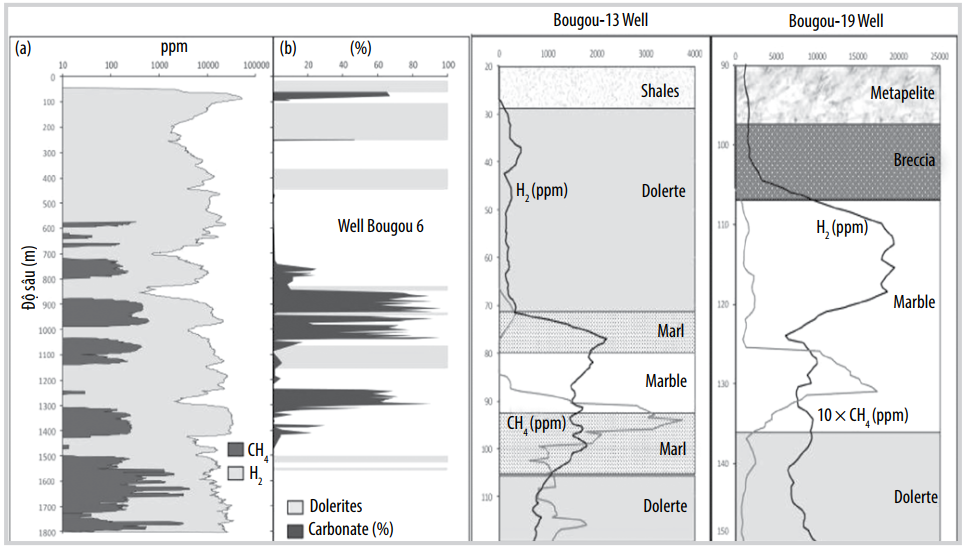
Figure 8. Left - Gas measurement data (a) and mineral data (b) from the deepest well, Bougou-6. Right - Gas measurements from wells Bougou-13 and 19: hydrogen (dark) and methane (light) [5].
Additionally, in Vietnam, there are many areas/targets that could serve as a foundation for research to search for hydrogen, similar to hydrogen discoveries worldwide, such as: i) ancient ophiolite belts (Cao Bang - Thai Nguyen, Vi Xuyen - Bac Ha - Muong Khuong, Song Da, Song Ma, Dakrong - Da Nang, Tam Ky - Phuoc Son, Southeast Vietnam [20]); ii) areas with ancient metamorphic formations (Kon Tum Massif, Fansipan); iii) mineral deposits (Thach Khe iron mine - Ha Tinh, Quy Xa iron mine - Lao Cai, Co Dinh chromite mine - Thanh Hoa, Bong Mieu gold mine - Quang Nam…); iv) coal basins (Quang Ninh, Thai Nguyen, Na Duong - Lang Son, Red River Delta…); v) areas with hot mineral springs (Kim Boi - Hoa Binh, Quang Hanh - Quang Ninh, Kenh Ga - Ninh Binh, Binh Chau - Ba Ria - Vung Tau…).
6. Conclusion and Recommendations
Hydrogen plays an important role in the energy transition, and the search and exploration for natural underground hydrogen is a new global field. Knowledge of the “hydrogen system” is in its early stages, and it needs further research to understand the mechanisms of hydrogen generation, storage, migration, trapping efficiency, and the potential for natural H2 accumulation in porous and permeable reservoir rocks, as well as the effectiveness of seals to prevent hydrogen from escaping the reservoirs.

| Figure 9. Depressed terrain areas in the Pleiku region - Chu Dang Ya Volcano (Gia Lai). | Figure 10. Depressed terrain areas in Plei Roih (Gia Lai). |
In Vietnam, there are geological areas and objects, both offshore and onshore, that exhibit signs and characteristics similar to regions where natural hydrogen has been discovered underground worldwide. This presents a favorable premise for the potential exploration of natural hydrogen underground in Vietnam in the near future.

| Figure 11. Depressed terrain areas - volcanic craters on Ly Son Island (Quang Ngai). | Figure 12. Tam Ky - Phuoc Son shear zone [21]. |
The group of authors proposes conducting research to evaluate and select areas with suitable geological and geomorphological characteristics for the processes of hydrogen generation and accumulation. Potential areas exhibiting signs of natural hydrogen include: i) offshore along the East Sea rift zone or sedimentary basins with intrusive magma activity and young volcanoes, such as the Phu Khanh and Cuu Long sedimentary basins; ii) onshore in regions like the South Central Coast, Central Highlands, and Northwest, where there are strong tectonic activities, complex fault systems, and areas with metallic and polymetallic mineral deposits.
Additionally, it is essential to review detailed geological documents, geological research results, drilling data, sample analyses, and assessments of the potential for the presence of natural hydrogen signs. This information will help formulate subsequent implementation directions.
Authors:
Nguyen Anh Duc - PetroVietnam
Phan Ngoc Trung - Vietnam Petroleum Institute
Source: Petrovietnam Journal

